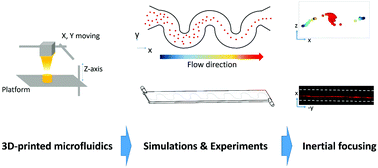Simulation and practice of particle inertial focusing in 3D-printed serpentine microfluidic chips via commercial 3D-printers†
Abstract
Inertial focusing of particles in serpentine microfluidic chips has been studied over the past decade. Here, a study to investigate the particle inertial focusing in 3D-printed serpentine microfluidic chips was conducted by simulation and practice. A test model was designed and printed using four commercial 3D-printers. Commercial inkjet 3D-printers have shown the best printing channel resolution of up to 0.1 mm. The force analysis of particle inertial focusing in 3D-printed microfluidic chips with large cross-sectional channels was discussed. Important parameters such as the channel curvature and flow velocity were studied by simulation. The optimal channel curvature and flow velocity are 5.9 mm and 480 μL min−1 (Re: 29.8 and De: 4.49) in the 3D-printed microfluidic chips with 0.2 mm × 0.4 mm cross-sectional channels. Under these optimal conditions, particles were well focused in the middle of the channel. Furthermore, two kinds of cancer cells were focused in these 3D-printed serpentine microfluidic chips under the optimal conditions. We envision that this improved study would provide helpful insights into simulating particle inertial focusing in 3D-printed microfluidic chips and promoting 3D-printed microfluidic chips to commercial production.



 Please wait while we load your content...
Please wait while we load your content...